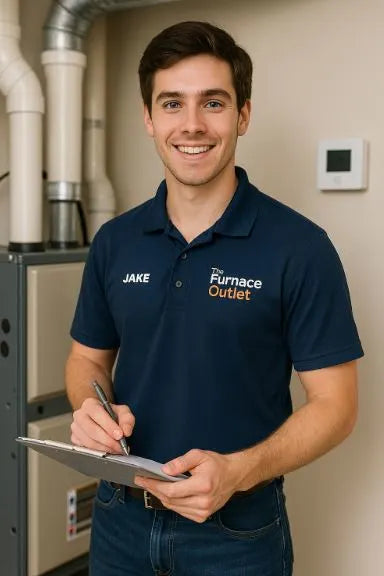Seasonal Furnace Maintenance Checklist: Keep Your System Running Like New
A furnace is more than just a home appliance; it's the heartbeat of your indoor comfort during colder months. Regular seasonal maintenance not only ensures warmth but also enhances efficiency, prolongs lifespan, and safeguards your family's health. This comprehensive guide provides a detailed seasonal furnace maintenance checklist, emphasizing the importance of timely upkeep and offering practical tips for homeowners.
🔍 Why Seasonal Furnace Maintenance Matters
Regular furnace maintenance is crucial for several reasons:
-
Enhanced Efficiency: A well-maintained furnace operates more efficiently, reducing energy consumption and lowering utility bills.
-
Extended Lifespan: Routine care can extend the furnace's lifespan, delaying costly replacements.
-
Improved Air Quality: Regular maintenance ensures better indoor air quality by preventing dust and allergens from circulating.
-
Safety Assurance: Proper maintenance reduces the risk of carbon monoxide leaks and other safety hazards.
📅 Seasonal Maintenance Breakdown
🍂 Fall: Pre-Heating Season Preparation
As temperatures drop, it's essential to prepare your furnace for the upcoming heating season:
-
Replace or Clean Air Filters: Dirty filters restrict airflow, causing the furnace to work harder. Replace or clean filters every 1–3 months, especially if you have pets or allergies.
-
Inspect Thermostat Settings: Ensure the thermostat is set to heating mode and functions correctly. Consider upgrading to a programmable thermostat for better energy management.
-
Check Carbon Monoxide Detectors: Test detectors to ensure they are operational. Replace batteries if necessary.
-
Inspect Ductwork for Leaks: Seal any visible leaks to prevent heat loss and improve efficiency.
-
Schedule Professional Inspection: Have a certified technician perform a comprehensive system check to identify potential issues.
❄️ Winter: Peak Heating Season
During the coldest months, maintaining your furnace's performance is critical:
-
Monitor System Performance: Pay attention to unusual noises, odors, or inconsistent heating, which may indicate underlying problems.
-
Ensure Proper Ventilation: Keep vents and registers unobstructed to allow for optimal airflow.
-
Maintain Humidity Levels: Use a humidifier to prevent dry air, which can affect both comfort and health.
🌸 Spring: Transition to Cooling Season
As you shift from heating to cooling, it's a good time to perform maintenance:
-
Replace Air Filters: Even if you replaced them in the fall, check and replace filters as needed.
-
Clean Furnace Area: Remove any debris or obstructions around the furnace to ensure proper airflow.
-
Schedule Professional Maintenance: Have a technician inspect the furnace to address any wear and tear before the next heating season.
☀️ Summer: Off-Season Care
Even when not in use, your furnace requires attention:
-
Inspect for Pests: Check for signs of rodents or insects that may have nested in the furnace area.
-
Clean Furnace Area: Dust and vacuum around the furnace to prevent buildup.
-
Check for Leaks: Inspect for any signs of water leaks or rust, which could indicate underlying issues.
🧰 Year-Round Maintenance Tips
In addition to seasonal tasks, consider these year-round maintenance practices:
-
Regular Filter Replacement: Change filters every 1–3 months, or more frequently if needed.
-
Keep Vents Unblocked: Ensure that furniture or drapes do not obstruct airflow from vents.
-
Monitor Energy Bills: A sudden increase in energy costs can signal inefficiency or issues with the furnace.
-
Schedule Annual Professional Inspections: An annual tune-up by a certified technician can catch potential problems early.
🛠️ DIY Maintenance vs. Professional Service
While homeowners can perform basic maintenance tasks, certain aspects require professional expertise:
-
DIY Tasks: Replacing air filters, cleaning around the furnace, and ensuring vents are unobstructed.
-
Professional Services: Inspecting and cleaning the heat exchanger, checking for gas leaks, and calibrating the thermostat.
Regular professional maintenance ensures that your furnace operates safely and efficiently. Professionals can identify issues that may not be apparent to homeowners, preventing costly repairs down the line.
💡 Common Furnace Issues to Watch For
Be vigilant for signs that may indicate your furnace needs attention:
-
Unusual Noises: Banging, rattling, or squealing sounds can point to mechanical issues.
-
Inconsistent Heating: Cold spots or uneven temperatures suggest airflow problems or ductwork issues.
-
Frequent Cycling: Short cycling can be caused by overheating, a dirty filter, or a malfunctioning thermostat.
-
Yellow Burner Flame: A yellow or flickering flame may indicate a carbon monoxide leak, which is a serious safety concern.
📊 Furnace Maintenance Cost Considerations
Investing in regular maintenance can save money in the long run:
-
Annual Inspection Costs: Typically range from ₹1,500 to ₹3,000, depending on the service provider and location.
-
Filter Replacement: Standard filters cost between ₹300 and ₹1,000, while high-efficiency filters may be more expensive.
-
Repair Costs: Minor repairs can range from ₹2,000 to ₹5,000, while major repairs or replacements can be significantly higher.
Regular maintenance can prevent costly emergency repairs and extend the lifespan of your furnace, providing better value over time.
🏠 Furnace Maintenance for Different Home Types
Furnace maintenance needs can vary based on the type and size of your home:
-
Single-Story Homes: Easier access to the furnace and ductwork simplifies maintenance tasks.
-
Multi-Story Homes: Ensure that all vents and registers are accessible and unobstructed.
-
Homes with Basements: Basements can be damp, increasing the risk of rust and corrosion in the furnace. Regular inspections are crucial.
-
Homes with Attics: Attics may have temperature extremes that can affect furnace components. Insulation and ventilation are key.
📝 Final Thoughts
Regular seasonal furnace maintenance is essential for ensuring your heating system operates efficiently and safely. By following this comprehensive checklist, you can prevent unexpected breakdowns, improve energy efficiency, and extend the lifespan of your furnace. Remember, when in doubt, consult a professional HVAC technician to address any concerns or perform complex maintenance tasks.
In the next Blog we will learn more about Understanding Furnace Blowers: ECM vs. PSC Motors and What You Should Know







